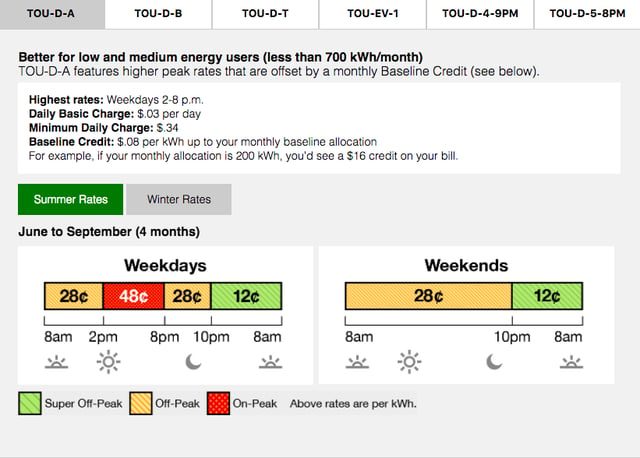SoCal Edison Electricity Rates Increase in 2018
20
March
2018
It's
common knowledge that the cost of solar panels and other solar related
technologies has dropped significantly over the past decade and will
continue to drop. Overall, this is a very good thing because it leads to
a higher rate of adoption by the general public.
One overlooked aspect, however, is the continuously increasing cost of electricity in the US, which is estimated to go up by 8.4% from Jan. 2018 to Dec. 2019.
The national trend of increased electricity rates is no different on the local level for customers of Southern California Edison (SCE). Recently, SoCal Edison announced an increase for their 2018 electricity rates and are planning to set a dynamic charging system for electricity consumption in 2019.
SoCal Edison’s pricing update casts a shadow over some of their other benefits, like their recent $10,000 BMW i3 incentive, but increased rates are expected for this industry. This is why to maximize your long-term energy savings it is important to install a solar panel system as soon as you can.
Here were the original rates for SoCal Edison:
There are a few noticeable changes. First, SoCal Edison has raised the threshold for entering each tier. The amount of kWh included in tier 1 increased by 9.9%, and the rate for this tier also went up by 6.25%. Similarly, the cost for tier 3 went up by 6.5%.
Another important thing to note is that the cost for tier 2 stayed the same, while the amount of kWh within this tier increased by almost 100. Extending the quantity of kWh within tier 2 and keeping the rate the same will be beneficial for the majority of households, but let’s see if this is true overall.
To get a better picture of how this may affect you, we can look at the average amount of electricity a household uses to see how much the overall bill would have increased.
In the United States, the average annual consumption of electricity in 2016 for a household was 10,766 kWh, or 897 kWh per month. If we go off of this data, we can calculate the cost by using the 897 kWh value. Here are the original and new costs for SoCal Edison’s plan:
It seems like SoCal Edison is targeting the outliers, and with this model they may be able to make enough additional revenue to leave the majority of consumers relatively untouched.

Here is some information that we can extract:
One overlooked aspect, however, is the continuously increasing cost of electricity in the US, which is estimated to go up by 8.4% from Jan. 2018 to Dec. 2019.
The national trend of increased electricity rates is no different on the local level for customers of Southern California Edison (SCE). Recently, SoCal Edison announced an increase for their 2018 electricity rates and are planning to set a dynamic charging system for electricity consumption in 2019.
SoCal Edison’s pricing update casts a shadow over some of their other benefits, like their recent $10,000 BMW i3 incentive, but increased rates are expected for this industry. This is why to maximize your long-term energy savings it is important to install a solar panel system as soon as you can.
SoCal Edison’s New Electricity Rates
SoCal Edison uses a tier system to determine the rate at which a customer will be charged for their electricity consumption. There are total of three tiers, and each tier has a different rate. The 3 tiers stack on top of one another and are based on the total quantity of electricity that the customer uses each month.Here were the original rates for SoCal Edison:
- Tier 1
0-324 kWh
$0.16/kWh - Tier 2
325-1296 kWh
$0.25/kWh - Tier 3
1297+ kWh
$0.31/kWh
- Tier 1
0-356 kWh
$0.17/kWh - Tier 2
357-1424 kWh
$0.25/kWh - Tier 3
1425+ kWh
$0.33/kWh
There are a few noticeable changes. First, SoCal Edison has raised the threshold for entering each tier. The amount of kWh included in tier 1 increased by 9.9%, and the rate for this tier also went up by 6.25%. Similarly, the cost for tier 3 went up by 6.5%.
Another important thing to note is that the cost for tier 2 stayed the same, while the amount of kWh within this tier increased by almost 100. Extending the quantity of kWh within tier 2 and keeping the rate the same will be beneficial for the majority of households, but let’s see if this is true overall.
To get a better picture of how this may affect you, we can look at the average amount of electricity a household uses to see how much the overall bill would have increased.
In the United States, the average annual consumption of electricity in 2016 for a household was 10,766 kWh, or 897 kWh per month. If we go off of this data, we can calculate the cost by using the 897 kWh value. Here are the original and new costs for SoCal Edison’s plan:
- Original Prices
(324 kWh * $0.16/kWh) + (573 kWh * $0.25/kWh) = $51.84 + $143.25 = $195.09 - New Prices
(356 kWh * $0.17/kWh) + (541 kWh * $0.25/kWh) = $60.52 + $135.25 = $195.77 (0.35% increase)
It seems like SoCal Edison is targeting the outliers, and with this model they may be able to make enough additional revenue to leave the majority of consumers relatively untouched.
SoCal Edison’s 2019 Rates
In 2019, SoCal Edison will be implementing a dynamic rate system where the cost for a customer’s electricity use will be based on when it is consumed, also called a Time Of Use (TOU) rate structure. Check out the details in the image below.
Here is some information that we can extract:
- The rates vary greatly throughout different times of the day
- The cost is significantly cheaper from 10pm to 8am
- Peak times are weekdays from 2pm to 8pm
No comments:
Post a Comment